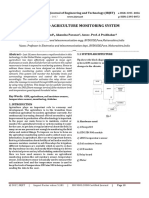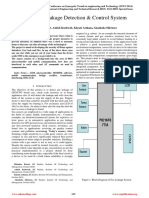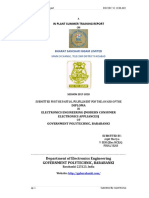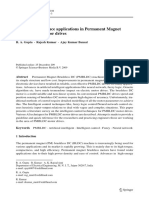Automatic Fire Detection Using GSM and Image Processing
Automatic Fire Detection Using GSM and Image Processing
Uploaded by
PriyadharshiniCopyright:
Available Formats
Automatic Fire Detection Using GSM and Image Processing
Automatic Fire Detection Using GSM and Image Processing
Uploaded by
PriyadharshiniOriginal Description:
Original Title
Copyright
Available Formats
Share this document
Did you find this document useful?
Is this content inappropriate?
Copyright:
Available Formats
Automatic Fire Detection Using GSM and Image Processing
Automatic Fire Detection Using GSM and Image Processing
Uploaded by
PriyadharshiniCopyright:
Available Formats
ISSN (Print) : 2320 – 3765
ISSN (Online): 2278 – 8875
International Journal of Advanced Research in Electrical,
Electronics and Instrumentation Engineering
(An ISO 3297: 2007 Certified Organization)
Vol. 5, Issue 5, May 2016
Automatic Fire Detection using GSM and
Image Processing
Santosh Kumar.M.B1, Surendra.J1, Shivanagouda Police Patil1, Rudramma.S1, Rajashekar.K2,
Hanumantha Reddy2
Final year UG Students, Dept. of Electrical & Electronics Engineering, RYM Engineering College, Ballari, Karnataka,
India1
Assistant Professor, Dept. of Electrical & Electronics Engineering, RYM Engineering College, Ballari, Karnataka,,
India2
ABSTRACT:The project is designed to develop a fire fighting robot using GSM technology for remote operation. The
robotic vehicle is loaded with water tanker and a pump which is controlled over wireless communication to sprinkle
water. An 8051 series of microcontroller is used for the desired operation. At the transmitting end using push buttons,
commands are sent to the receiver to control the movement of the robot either to move forward, backward and left or
right etc. At the receiving end three motors are interfaced to the microcontroller where two of them are used for the
movement of the vehicle and the remaining one to position the arm of the robot. The GSM transmitter acts as a GSM
remote control that has the advantage of adequate range (up to 200 meters) with proper antenna, while the receiver
decodes before feeding it to another microcontroller to drive DC motors via motor driver IC for necessary work. A
water tank along with water pump is mounted on the robot body and its operation is carried out from the
microcontroller output through appropriate signal from the transmitting end. The whole operation is controlled by an
8051 series microcontroller. A motor driver IC is interfaced to the microcontroller through which the controller drives
the motors. Further the project can be enhanced by interfacing it with a wireless camera so that the person controlling it
can view operation of the robot remotely on a screen.
KEYWORDS: Smoke Sensor, flame sensor, Temperature sensor, image processing, microcontroller, solenoid pump.
I.INTRODUCTION
The project is designed to develop a Automatic Fire Detection using GSM and image Proceesing using GSM
technology for remote operation. The robotic vehicle is loaded with water tanker and a pump which is controlled over
wireless communication to throw water. An 8051 series of microcontroller is used for the desired operation. At the
transmitting end using push buttons, commands are sent to the receiver to control the movement of the robot either to
move forward, backward and left or right etc. At vehicle and the remaining one to position the arm of the robot. The
GSM transmitter acts as a GSM remote control that has the advantage of adequate range (up to 200 meters) with proper
antenna, while the receiver decodes before feeding it to another microcontroller to drive DC motors via motor driver IC
for necessary work. A water tank along with water pump is mounted on the robot body and its operation is carried out
from the microcontroller output through appropriate signal from the transmitting end. The whole operation is controlled
by an 8051 series microcontroller. A motor driver IC is interfaced to the microcontroller through which the controller
drives the motors. Further the project can be enhanced by interfacing it with a wireless camera so that the person
controlling it can view operation of the robot remotely on a screen.
H21A1 module is the main part of the circuit. The important feature of a fire detecting system is the smoke sensor. By
detecting smoke, the fire accident can be escaped. There are a wide variety of smoke sensors used in fire alarm systems.
Smoke detectors operate on the principle of detecting the presence of a certain level of smoke particles within the area
being monitored. Once the threshold level of smoke particles in the area has been exceeded, the smoke detector
indicates the alarm condition. Such smoke detectors may operate on photoelectric light scattering principle.
Copyright to IJAREEIE DOI:10.15662/IJAREEIE.2015.0505118 4107
ISSN (Print) : 2320 – 3765
ISSN (Online): 2278 – 8875
International Journal of Advanced Research in Electrical,
Electronics and Instrumentation Engineering
(An ISO 3297: 2007 Certified Organization)
Vol. 5, Issue 5, May 2016
II. BLOCK DIAGRAM OF PROPOSED SYSTEM
The block diagram of Automatic Fire Detection using GSM and image Processing consists of the following blocks
1. Flame detector
2. Temperature detector
3. Microcontrollers
4. Temperature detector
SMOKE
DETECTOR
FLAME DETECTOR GSM MODEM
TEMPERATURE MICROCONTROLLER
DETECTOR LCD DISPLAY
230V SUPPLY
12V SUPPLY
WATER PUMP
Figure 1.BLOCK DIAGRAM OF PROPOSED SYSTEM
Flame detector: Flame detectors may comprise an optical sensor for detecting electromagnetic radiation, for example,
visible, infrared or ultraviolet, which is indicative of the presence of a flame. A flame detector may detect and measure
infrared (IR) radiation, for example in the optical spectrum at around 4.3 microns, a wavelength that is characteristic of
the spectral emission peak of carbon dioxide. An optical sensor may also detect radiation in an ultraviolet range at
about 200-260 nanometers. This is a region where flames have strong radiation, but where ultra-violet energy of the sun
is sufficiently filtered by the atmosphere so as not to prohibit the construction of a practical field instrument. In this
Circuit we use photodiode as a sensor which detect the flame which is from electric shot and OPAM is used to amplify
the data so that at correct time buzzer is sound.
Temperature detector: The LM56 is a precision low power thermostat. Two stable temperature trip points (VT1 and
VT2) are generated by dividing down the LM56 1.250V band gap voltage reference using 3 external resistors. The
LM56 has two digital outputs.OUT1 goes LOW when the temperature exceeds T1 and goes HIGH when the
temperature goes below (T1±THYST). Similarly, OUT2 goes LOW when the temperature exceeds T2 and goes HIGH
Copyright to IJAREEIE DOI:10.15662/IJAREEIE.2015.0505118 4108
ISSN (Print) : 2320 – 3765
ISSN (Online): 2278 – 8875
International Journal of Advanced Research in Electrical,
Electronics and Instrumentation Engineering
(An ISO 3297: 2007 Certified Organization)
Vol. 5, Issue 5, May 2016
when the temperature goes below (T2±THYST).THYST is an internally set 5§C typical hysteresis. The LM56 will be
available in an 8-lead Mini-SO8 surface mount package and is currently available in an 8-lead small outline package.
Microcontrollers: Rich in peripherals: The PIC microcontroller has many built in peripherals which can be utilized for
various purposes. The 40 pins of 8051 make it easier to use the peripherals as the functions are spread out over the pins.
This makes it easier to decide what external devices to attach without worrying too much if there enough pins to do the
job.
1) Low power consumption:
The controller works with a low power supply such as 12V DC.
2) Easy programming, cheap and reliable: It is easy in programming with ‘c’ language.
Temperature detector: A GSM modem is a wireless modem that works with a GSM wireless network. A wireless
modem behaves like a dial-up modem. The main difference between them is that a dial-up modem sends and receives
data through a fixed telephone line while a wireless modem sends and receives data through radio waves. A GSM
modem can be an external device or a PC Card / PCMCIA Card. Typically, an external GSM modem is connected to a
computer through a serial cable or a USB cable. A GSM modem in the form of a PC Card / PCMCIA Card is designed
for use with a laptop computer. It should be inserted into one of the PC Card / PCMCIA Card slots of a laptop
computer. Like a GSM mobile phone, a GSM modem requires a SIM card from a wireless carrier in order to operate.
Computers use AT commands to control modems. Both GSM modems and dial-up modems support a common set of
standard AT commands. A GSM modem is just like a dial-up modem. In addition to the standard AT commands, GSM
modems support an extended set of AT commands. These extended AT commands are defined in the GSM standards.
The number of SMS messages that can be processed by a GSM modem per minute is very low They are only about six
to ten SMS messages per minute.
III.WORKING OF AUTOMATIC FIRE DETECTION USING GSM AND IMAGE
PROCESSING
There are several possibilities a fire can start in any remote area or in an industry. For instance, in garments, cotton
mills, fuel storages electric leakages will result in immense harm. Also, it’s a worst case scenario, causing heavy losses
not only financially, but also conjointly destroying areas surrounding it. Robotics is the rising answer to guard the
human lives, wealth and surroundings. A Firefighting robot is designed and built will be designed with an embedded
system. It should be able to separately navigate through a modeled floor plan, whereas actively scanning for a flame.
The robot will even act as a path guide in normal case associated as a fireplace device in an emergency. These robots
are designed to search out a fireplace, before it ranges out of control, will sooner or later work with firefighters greatly
reducing the danger of injury to victims. The Firefighting robot project will help generate interest as well as
innovations within the fields of robotics while operating towards a sensible and obtainable solution to save lives and
mitigate the danger of property harm. Fire Fighting Robot Remotely Operated by Android Applications The main
intention of this project is to design a fire fighting robot using android application for remote operation. The
firefighting robot includes a water tanker, that is used to pump the water on fire and it is controlled over wireless
communication. For the desired operation, microcontrollers issued. In the proposed system, RF module application is
used to send commands from the transmitter end to the receiver end to control the movement of the robot either to
move forward, backward, right or left. At the receiver side, two motors are interfaced to the 8051 microcontroller
where two of them are used for the movement of the vehicle and the remaining one to place the arm of the robot. The
main goal of this project is to design a fire fighting robot using RF technology for remote operation. This robot is
loaded with a water tanker with a pump which is controlled over wireless communication to sprinkle water. For the
desired operation, an 8051 microcontroller is used. At the transmitter end, push buttons are used to send commands to
the receiver end to control the robot movement, either to forward, backward & right or left. The RF transmitter acts as
an GSM remote control that has the benefit of adequate range up to 200 meters with apposite antenna, while the
decoder decode before feeding it to another microcontroller to drive DC motors via motor driver IC for necessary work.
A water tank with pump is placed on the robot body and its operation is carried out from the microcontroller o/p
through the proper signal from the transmitting end. The entire operation is controlled by a microcontroller. A motor
driver IC is interfaced to the microcontroller through which the controller drives the motor. In future, this project can be
developed by interfacing it with a wireless camera so that the person can view the controlling operation of the robot remotely
on a display.
Copyright to IJAREEIE DOI:10.15662/IJAREEIE.2015.0505118 4109
ISSN (Print) : 2320 – 3765
ISSN (Online): 2278 – 8875
International Journal of Advanced Research in Electrical,
Electronics and Instrumentation Engineering
(An ISO 3297: 2007 Certified Organization)
Vol. 5, Issue 5, May 2016
IV.METHODOLOGY
The project uses HT12E Encoder which converts 4-bit data to serial output which is then fed to the GSM module for
transmitting the same to be received by the receiver RF module the output of which is fed to HT12D the serial decoder IC, the
output of which is fed to controller. The transmitting end MC is connected to a set of pushbutton. Thus while a particular
button is pressed the program executed delivers corresponding 4-bit data which are then transmitted serially at port 1. The
data so received at the receiver end of port 1 operates the motor through motor driver IC L293D as required being interfaced
from the Microcontroller output port 2. The transmitter is powered by a 6v battery in series with a silicon diode to finally
develop required voltage for microcontroller circuit. The receiver is powered by a 12v battery in series with a silicon diode to
protect the circuits from accidental reverse battery connection. 5V DC out of the 12V available from regulator IC 7805 is fed
to the controller, decoder, the motor driver IC L293D pin 8 for operation of the motor. The receiving unit uses one more
motor driver IC L293D for driving one DC Motor for arm operation with a boom mounted on its shaft. At the end of the shaft
a nozzle is connected to a water tanks mounted water pump which is powered from “NO” contacts of a relay that is driven by
transistor Q1 from the output of MC pin 15, thus in the event of a fire the robotic vehicle is moved over to the location by
operating the left, right, forward & backward button etc. After it reaches the site the nozzle mounted motor takes position
through the water on the fire from the water tank mounted DC pump actuated by the relay RL1. Thus the fire can be
extinguished.
V. RESULTS AND DISCUSSION
One of the key issues of the COMETS project is the demonstration. The project is being demonstrated in fire detection and
monitoring activities, and also forterrain mapping missions.Several experiments with controlled small fires havebeen carried
out at Lousa. The controlled fires used in the firedetection tests are originated by the burning of small shrubs.A set of
sequences of images containing fire alarms and potential false alarms (heated objects, etc) were recorded. The individual fire
segmentation algorithms for infrared and visual cameras, and the data fusion techniques were applied over the images. For
each case, the probabilities of detection PD and false positive PF were computed as: PD as the average of the ratio between
pixel detected correctly and the complete set of pixels corresponding to fire. PF as the average of the ratio of detected pixels
not being fire and the total number of pixels of one image Manually segmented images has been used as groun truth to
compute these quantities. Table 1 shows the results of the fusion algorithms. Also, the detection procedure has been applied
on actual flights. Figure 9 shows a flight carried out byTable 1 Results of the data fusion algorithms. Algorithm PD PF IR
0.962 0.045 Visual 0.819 0.023 Combined 0.981 0.003 the Helivision helicopter, and marked as 1 the estimated position of
the alarm. With the current sensors, the estimated position is within 5 meters of the actual position (recorded by using a GPS).
Fig 2. Actual flight during Lousa experiments.
Dashed, trajectory of the helicopter. Labelled as
1, the estimated position of the alarm. The actual
position is also presented (axis in meters).
Copyright to IJAREEIE DOI:10.15662/IJAREEIE.2015.0505118 4110
ISSN (Print) : 2320 – 3765
ISSN (Online): 2278 – 8875
International Journal of Advanced Research in Electrical,
Electronics and Instrumentation Engineering
(An ISO 3297: 2007 Certified Organization)
Vol. 5, Issue 5, May 2016
Figure 3 . shows the Automatic Fire Detection using GSM and image Proceesing ,it consists of gsm ,lcd,solar
panel, 5v battery, h-bridge, 2v dc motors,water pump and storage tank.
VI.CONCLUSION
This Project presents a Automatic Fire Detection using GSM and image Proceesing using GSM communication and it
is designed and implemented with Atmel 89S52 or 8051 microcontroller (MCU) in embedded system domain.
Experimental work has been carried out carefully. The result shows that higher efficiency is indeed achieved using the
embedded system. The proposed method is verified to be highly beneficial for the security purpose and industrial
purpose. At present the robot is capable of throwing water with high flow rate only. At future the robot will also
capable of throwing water with controlled robotic arms and the object detection using cameras on it. It can be used as
further extension of the project to achieve all the features.
REFERENCES
[1]. Blake,D., Aircraft Cargo Compartment Smoke Detector Alarm Incidents on U.S.- Registered Aircraft, 1974-1999, DOT/FAA/AR-TN00/29,
Federal Aviation Administration, Atlantic City, NJ
[2]. Phillips,T., Cabin & Fire Safety: A Perspective From the Cockpit, International Aircraft Fire and Cabin Safety Research Conference, Atlantic
City, NJ (1998) Cleary,T., Grosshandler,W., Survey of Fire Detection Technologies and System
[3] Evaluation/Certification Methodologies and Their Suitability for Aircraft Cargo Compartments, NISTIR 6356, NIST, Gaithersburg, MD
(1999)Audoin,L., Kolb,G., Torero,J.L., Most,J.M., Fire Safety Journal 1995; 24:167-187
[4]. Goedeke,A.D., Droa,B., Viglione,S., Gross,H.G., Fire detection systems, USPatent 5’153’722 (1992)
[5] Foo,S.Y., Knowledge-based systems 1996, 9:531-540
[6] Cheng,X., Wu,J., Yuan,X., Zhou,H., Fire Safety Journal 1999; 33:57-69
[7] Plumb,O.A., Richards,R.F., Development of an Economical Video Based Fire Detection and Location System, NIST GCR 96-695, NIST,
Gaithersburg, MD(1996)
[8] EN54: Components of Automatic Fire Detection Systems, European Comitee for Standardisation, July 1982
Arrue, B.C., Ollero, A and Martinez de Dios, J.R.,(2000). An Intelligent System for False Alarm Reduction in Infrared Forest-Fire Detection, IEEE
Intelligent Systems, vol. 15, no. 3, pp-64- 73.
Copyright to IJAREEIE DOI:10.15662/IJAREEIE.2015.0505118 4111
You might also like
- Chapter 1 - PLC OverviewDocument52 pagesChapter 1 - PLC OverviewApoorva Kulkarni67% (3)
- Iot Based Condition Monitoring of Transformer IJERTV11IS010088Document4 pagesIot Based Condition Monitoring of Transformer IJERTV11IS010088iron4635No ratings yet
- IJCRT22A6112Document7 pagesIJCRT22A6112tamannakouser1812No ratings yet
- IJSDR2003046Document5 pagesIJSDR2003046tamannakouser1812No ratings yet
- IOT Based Diagnosing of Fault Detection in Power Line Distribution Using ArduinoDocument6 pagesIOT Based Diagnosing of Fault Detection in Power Line Distribution Using ArduinoTolesa ShoreNo ratings yet
- AAAAAALL Components ForDocument22 pagesAAAAAALL Components ForSV TechnologiesNo ratings yet
- Solar Panel Monitoring System Using GSMDocument7 pagesSolar Panel Monitoring System Using GSMBaliom AbaNo ratings yet
- Microcontroller Based Automatic FlameDocument4 pagesMicrocontroller Based Automatic Flamelailusriy200498No ratings yet
- Electrical Appliances Control Through TV RemoteDocument18 pagesElectrical Appliances Control Through TV RemotesrikaanthelectricalNo ratings yet
- Wearable Electrical Device Control With Audio NotificationDocument45 pagesWearable Electrical Device Control With Audio NotificationmuhammedfarhanNo ratings yet
- A Major Project Seminar On Zig Bee Based Intelligent Helmet For Coal MinersDocument20 pagesA Major Project Seminar On Zig Bee Based Intelligent Helmet For Coal MinersakashlogicNo ratings yet
- Im Lpe MentationDocument5 pagesIm Lpe MentationgokulaNo ratings yet
- Partial Discharge Ultraviolet Detection Technology Applied N Enclosed High-Voltage Electrical AppliancesDocument4 pagesPartial Discharge Ultraviolet Detection Technology Applied N Enclosed High-Voltage Electrical AppliancesbabakfazelNo ratings yet
- IJSRDV7I20141Document4 pagesIJSRDV7I20141aadiprojects9081No ratings yet
- MDD PPT Keerti Third ReviewDocument20 pagesMDD PPT Keerti Third Reviewkeeru mbsNo ratings yet
- Iot Based Distribution Transformer Health Monitoring System Using Arduino Nodemcu and Thingspeak IJERTV8IS040459Document4 pagesIot Based Distribution Transformer Health Monitoring System Using Arduino Nodemcu and Thingspeak IJERTV8IS040459iron4635No ratings yet
- Animal Detection System in Farm Areas: IjarcceDocument5 pagesAnimal Detection System in Farm Areas: IjarcceSanketh ReddyNo ratings yet
- B11_PRC2Document19 pagesB11_PRC2hiteshshrma112No ratings yet
- Design of GSM Based Smoke Detection and Temperature Monitoring SystemDocument7 pagesDesign of GSM Based Smoke Detection and Temperature Monitoring SystemDayanidhi NaikNo ratings yet
- Smart SubstationDocument49 pagesSmart SubstationSai PunithNo ratings yet
- Batch2 FulldocDocument21 pagesBatch2 FulldocPushparaj PalanisamyNo ratings yet
- Automated Greenhouse Monitoring and Control System PDFDocument9 pagesAutomated Greenhouse Monitoring and Control System PDFSaiKrishna100% (2)
- Industrial Protection System Using Arduino and Bluetooth ModuleDocument32 pagesIndustrial Protection System Using Arduino and Bluetooth Modulehamed razaNo ratings yet
- Fin Irjmets1654848091Document4 pagesFin Irjmets1654848091morshedabhuyian13No ratings yet
- IoT Based Smart Sewage Monitoring System Using GSM and Wi-Fi ModuleDocument4 pagesIoT Based Smart Sewage Monitoring System Using GSM and Wi-Fi ModuleInternational Journal of Innovative Science and Research TechnologyNo ratings yet
- GSM Based Industrial Security System: Abstract: Security and Automation Is A PrimeDocument6 pagesGSM Based Industrial Security System: Abstract: Security and Automation Is A PrimeMuhammed JaleelNo ratings yet
- Design and Simulation of Fan Speed Control Using Arduino UNO and LM35DZDocument5 pagesDesign and Simulation of Fan Speed Control Using Arduino UNO and LM35DZAro YeeNo ratings yet
- Final Report 2020Document26 pagesFinal Report 2020Siva BadrinathNo ratings yet
- Fig1.1 Hardware Circuit of GSM ModemDocument53 pagesFig1.1 Hardware Circuit of GSM ModemShashank KUmar Rai BhadurNo ratings yet
- IJRESM_V3_I3_13Document4 pagesIJRESM_V3_I3_13muhammedshiyasgamer2002No ratings yet
- Feeder Protection From Over Load and Earth Fault RelayDocument6 pagesFeeder Protection From Over Load and Earth Fault RelayrajeshNo ratings yet
- Degital Alarm ClockDocument3 pagesDegital Alarm ClockAsdfghjklNo ratings yet
- Iot Based Flood Monitoring and Controlling SystemDocument9 pagesIot Based Flood Monitoring and Controlling SystemAnisha Arya AryaNo ratings yet
- Major ProjectDocument18 pagesMajor Projectanubhavpandey1549No ratings yet
- Solar Weather StationDocument23 pagesSolar Weather StationAkhilVuritiNo ratings yet
- Ijireeice 12Document5 pagesIjireeice 12haouhaw0No ratings yet
- International Journal of Engineering and Science Invention (IJESI)Document8 pagesInternational Journal of Engineering and Science Invention (IJESI)inventionjournalsNo ratings yet
- GSM Based Home Security SystemDocument20 pagesGSM Based Home Security SystemDhirendra Singh Rajput79% (14)
- Differential Protection of Transformer Using ArduinoDocument4 pagesDifferential Protection of Transformer Using ArduinoVIVA-TECH IJRINo ratings yet
- Real - Time Envirnorment Monitoring System and Data Logger Using Arm ProcessorDocument5 pagesReal - Time Envirnorment Monitoring System and Data Logger Using Arm ProcessorInternational Journal of computational Engineering research (IJCER)No ratings yet
- 161 Microcontroller NewDocument8 pages161 Microcontroller NewHari KishorNo ratings yet
- M2M Communication Based Wireless SCADA For Real-Time Industrial AutomationDocument3 pagesM2M Communication Based Wireless SCADA For Real-Time Industrial AutomationAutoyearNo ratings yet
- Cooperative Flood Detection Using Sms Through IotDocument5 pagesCooperative Flood Detection Using Sms Through IotAnonymous 6FUcbaPNo ratings yet
- GAS & Smoke Leakage Detection and Automatic Valve Control SystemDocument3 pagesGAS & Smoke Leakage Detection and Automatic Valve Control SystemManivannanNo ratings yet
- GSM Based Agriculture Monitoring SystemDocument5 pagesGSM Based Agriculture Monitoring SystemAnonymous kw8Yrp0R5rNo ratings yet
- Sciencedirect: Security Based DomoticsDocument7 pagesSciencedirect: Security Based Domoticsz3ppelinNo ratings yet
- Smart Metering For Low Voltage Using Arduino Due PDFDocument6 pagesSmart Metering For Low Voltage Using Arduino Due PDFUmeshNo ratings yet
- Lab Manual 2022Document23 pagesLab Manual 2022Ashutosh ShuklaNo ratings yet
- Arduino Based Firefighting RobotDocument7 pagesArduino Based Firefighting RobotLaxmi RathodNo ratings yet
- JETIR2210284Document4 pagesJETIR2210284nisha sharmsNo ratings yet
- GSM Based Home Security SystemDocument20 pagesGSM Based Home Security SystemRonald AbletesNo ratings yet
- ARM Based Smart Power Saving System For Home Automation: Madhu M S, Gangadhar M Sanjaya G CDocument4 pagesARM Based Smart Power Saving System For Home Automation: Madhu M S, Gangadhar M Sanjaya G CSurajguptarocksNo ratings yet
- P39-43 PDFDocument5 pagesP39-43 PDFyahya khanNo ratings yet
- Project Name: Greenhouse Monitoring System Using ArduinoDocument8 pagesProject Name: Greenhouse Monitoring System Using ArduinoyumnaNo ratings yet
- Ijetr April 2014 Stet 36Document5 pagesIjetr April 2014 Stet 36akashNo ratings yet
- Automatic Water Sprinkling System Based On Intensified Fire Detection System Using Proteus and Keil CDocument11 pagesAutomatic Water Sprinkling System Based On Intensified Fire Detection System Using Proteus and Keil CIJRASETPublicationsNo ratings yet
- 4.development of Electricity Theft Detection Using Smart Meter in Power Distribution Network Based On Wireless TechnologyDocument9 pages4.development of Electricity Theft Detection Using Smart Meter in Power Distribution Network Based On Wireless Technology1382aceNo ratings yet
- Lecture 23 Intro To Optical Amplifiers PDFDocument12 pagesLecture 23 Intro To Optical Amplifiers PDF0938089460No ratings yet
- SSP 3 2 - Spectrum 2Document13 pagesSSP 3 2 - Spectrum 2Gabor GerebNo ratings yet
- Lab 2 Zener and LEDsDocument6 pagesLab 2 Zener and LEDsAlisha AasNo ratings yet
- LSI Logic Design Chapter 2Document58 pagesLSI Logic Design Chapter 2coipham1104No ratings yet
- Rectangular Patch AntennaDocument81 pagesRectangular Patch AntennaSulaim King X100% (2)
- 2018 June - Unit 2 ExamDocument32 pages2018 June - Unit 2 ExamAdam - Salvatore KebboucheNo ratings yet
- Vol I PDFDocument450 pagesVol I PDFAnishNo ratings yet
- 230V MSB - STBD.: Alarm SystemDocument2 pages230V MSB - STBD.: Alarm SystemhamzehNo ratings yet
- BSNL ST Report Final PDFDocument42 pagesBSNL ST Report Final PDFShashank MishraNo ratings yet
- MB Manual Ga-z87x-Ud3h eDocument124 pagesMB Manual Ga-z87x-Ud3h ejazz240% (1)
- RA2111003010562 Physics Assignment 5Document6 pagesRA2111003010562 Physics Assignment 5abhiverm05No ratings yet
- IRDA SMD & BGA Rework Station T862 User Manual: Puhui Technology (Taian) - CO., LTDDocument11 pagesIRDA SMD & BGA Rework Station T862 User Manual: Puhui Technology (Taian) - CO., LTDbehzadNo ratings yet
- 1-5 Glossary of Common Ham Radio TermsDocument7 pages1-5 Glossary of Common Ham Radio Termshball1983No ratings yet
- Gupta2010 Article ArtificialIntelligenceApplicat PDFDocument12 pagesGupta2010 Article ArtificialIntelligenceApplicat PDFJohn XaviNo ratings yet
- Lean Manufacturing Glass WallDocument96 pagesLean Manufacturing Glass WalldkeplpcproductionNo ratings yet
- FL591FL Laser Diode Driver BrochureDocument2 pagesFL591FL Laser Diode Driver BrochureWavelength Electronics, Inc.No ratings yet
- The CANOpen Protocol - Structure, Scope, Applications and Future ProspectsDocument20 pagesThe CANOpen Protocol - Structure, Scope, Applications and Future ProspectsVedant Prusty100% (1)
- 4 Jarless-con英文调试说明书Document34 pages4 Jarless-con英文调试说明书ArmandRoseNo ratings yet
- Monitor Acer LCD AL1516WDocument41 pagesMonitor Acer LCD AL1516WRonan Nolasco0% (1)
- Building An AnalogDocument10 pagesBuilding An AnalogRosita AzzamNo ratings yet
- Proposed: Soil Resistivity Two-Layer Model, Standard and Standard 81-1983Document3 pagesProposed: Soil Resistivity Two-Layer Model, Standard and Standard 81-1983Carlos Andrés Ruiz HernandezNo ratings yet
- Manpack RadioDocument2 pagesManpack RadioBHATARA88100% (1)
- WBR ReceiverDocument5 pagesWBR ReceiverFW De LangenNo ratings yet
- Ailtech 7600 Series Noise Generator Operation and Service Manual, 11-1980.Document26 pagesAiltech 7600 Series Noise Generator Operation and Service Manual, 11-1980.Bob Laughlin, KWØRLNo ratings yet
- Eee 334 Lab 1 Ltspice and Lab Orientation - Instruments and MeasurementsDocument18 pagesEee 334 Lab 1 Ltspice and Lab Orientation - Instruments and MeasurementsplaystationNo ratings yet
- Input/Output SystemsDocument94 pagesInput/Output SystemsSrikanth PrasadNo ratings yet
- (6ep1961-3ba21) Redundancy ModuleDocument2 pages(6ep1961-3ba21) Redundancy ModuleRyan TorresNo ratings yet
- Radio Navigation Oxford QUESTION BANKDocument147 pagesRadio Navigation Oxford QUESTION BANKPrajwal hrNo ratings yet
- Ethiopia Energy Efficiency and Planning Goals TakeleDocument27 pagesEthiopia Energy Efficiency and Planning Goals TakeleAyoub EnergieNo ratings yet

























































































